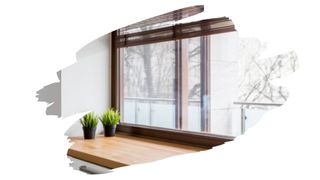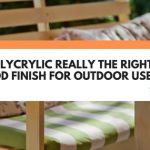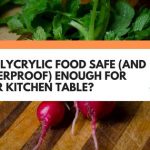The best way to protect any countertop is to seal it with a waterproofing top coat. Not only will that sealant help prevent water from damaging that wooden countertop, it will also safeguard it from scratches too.
Now, a kitchen countertop needs a durable sealer that can shrug of water spills, scratches, and the heat of a hot pan. But, is Polycrylic one such sealer?
Well, in this post, you will learn what makes for a food-safe finish — and whether or not Polycrylic fits the bill. You will also find out what type of wood sealant offers the most waterproofing top coat for a kitchen countertop.

This post may contain affiliate links to products that we receive a commission for (at no additional cost to you). Learn more here.
How Do You Seal And Waterproof A Wooden Countertop After Painting It?
If you want to protect any wooden surface from water damage, then you need to cover it with a low-maintenance waterproofing wood sealer.
And the most water-resistant wood sealers tend to be urethane-based, such as polyurethane or spar varnish. This is because, (unlike oil finishes such as Linseed or Tung oil), they prevent not only water droplets, but also water vapor from getting past their film.
And when it comes to interior wooden surfaces, a penetrating oil-based polyurethane sealant is ideal.
Now, oil-based polyurethanes don’t cure as fast as water-based ones — and they release more fumes as they dry. But, they are more durable, and leave wooden surfaces looking more natural.
What Are Urethane-Based Sealers Food Safe Enough For A Kitchen Countertop?
Well, generally, if a wood sealant cures into a solid film, then it is pretty much food safe. In fact, to go a step further, a wholly food-safe sealer is one that both cures AND only contains FDA-approved food-safe resins.
So, this means that Polycrylic, (after it has cured), is a food safe sealant that can be applied onto any dining tabletop.
Related Post: Is Polycrylic Food Safe (And Waterproof) Enough For Your Kitchen Table?
And Is Polycrylic Food-Safe Enough To Coat A Kitchen Countertop?
Absolutely, because as a food-safe sealant it doesn’t pose a health risk if it comes into indirect contact with food.
You see, food-safe sealants (and paints and finishes) all contain resins and other ingredients in them that are not safe for consumption. This is why you wouldn’t want them coating a chopping block or charcuterie board.
Basically, even though they’re food-safe, you still don’t want to risk bits of these sealants getting into your meal.
Nevertheless, once they are dry and have solidified (i.e. cured) they no longer leech resins or release fumes. So, they can be ‘near’ food — but not have direct food contact.
Is Polycrylic The Same Thing As Polyurethane? Polycrylic is a water-based acrylic urethane blended product made by Minwax. It protects wood like most water-based polyurethanes, leaving behind a clear finish that enhances the look of wood.
What About Heat? Is Polycrylic Heat Resistant Enough To Be Put On A Kitchen Countertop?
It is fairly heat-resistant up to a point. But, to be fair, the same can be said for most polyurethane sealers.
You see, polyurethane can stand temperatures of up to 200°F (93°C). So, as long as you don’t directly place pans of boiling water atop this finish, it can handle a bit of heat.
Still, oil-based polyurethanes tend to manage high temperatures better than water-based finishes all the same.
So Why Wouldn’t You Use Polycrylic Vs Polyurethane On Countertops?
A regularly used kitchen countertop will see a lot of water-spills, moisture and the like. On top of that, every now and then, it’ll have a hot pot or pan placed on it as well.
So, any sealant you use on a kitchen countertop needs to be very waterproof.
But, Polycrylic is only a fairly water-resistant top coating sealant. It can brush off the odd water spill here and there, but in high humidity environments it won’t do as well.
This is why this finish is best suited for interior wood — especially as rain and damp outside will damage this sealant.
What’s more, if that coat of Polycrylic happens to get drenched, water will soak past it into the wood underneath.
Now, you can still use Polycrylic to seal dining table tops. You simply need to use coasters, place mats, and table cloths to protect the finish.
But, laying down a few place mats as you prepare food on a kitchen countertop kind of defeats the purpose. And if you happen to regularly get the odd liquid spill on that kitchen countertop, then a Polycrylic sealant will become damaged.
In short, you need a more waterproof sealant for a regularly used kitchen countertop.
Related Post: Should You Even Bother Applying Polyurethane Over Polycrylic?
So Is Polycrylic — Or Oil-Based Polyurethane — Better For A Kitchen Surface?
When it comes to certain dining surfaces, such as say a table, you can freely apply Polycrylic onto it. That’s because you can always make sure you use coasters and place mats to protect that finish from wet glasses and hot plates.
But, coasters and mats aren’t a practical solution for protecting a kitchen countertop — especially if you regularly use the surface to prepare all manner of food.
So you are better off using a more waterproof oil-based polyurethane sealer.
Oil-based polys are more durable since they penetrate deeper into wood. And they are more heat resistant than water-based finishes too.
To Wrap Up, Here Are The 3 Key Takeaways From This Post…
- 1). Polycrylic is a water-based acrylic urethane blended finish that does a fantastic job at safeguarding interior wood surfaces.
- 2). It is a food-safe finish — but only after it has dried and cured into a solid durable film.
- 3). However, it is not wholly waterproof. And a Polycrylic seal can become damaged if you leave hot cups or plates on it.


![Help! Why Are There Air Bubbles In My Polycrylic Finish! [+ What You Can Do To Fix It] bubbles in polycrylic finish](https://www.thewoodworkplace.com/wp-content/uploads/2022/10/Banner-490-150x150.jpg)
